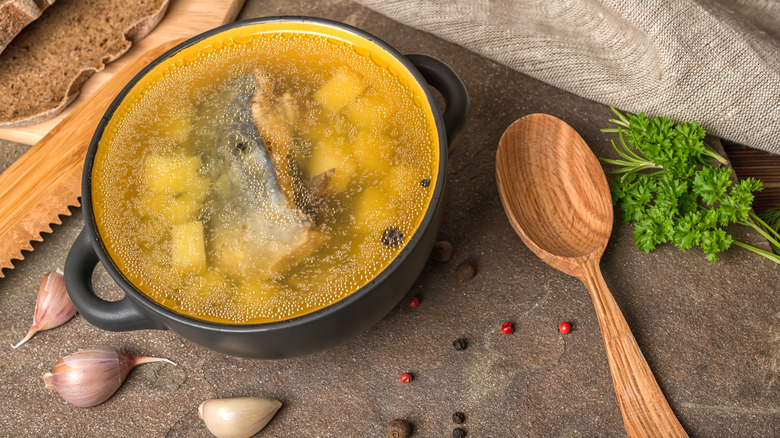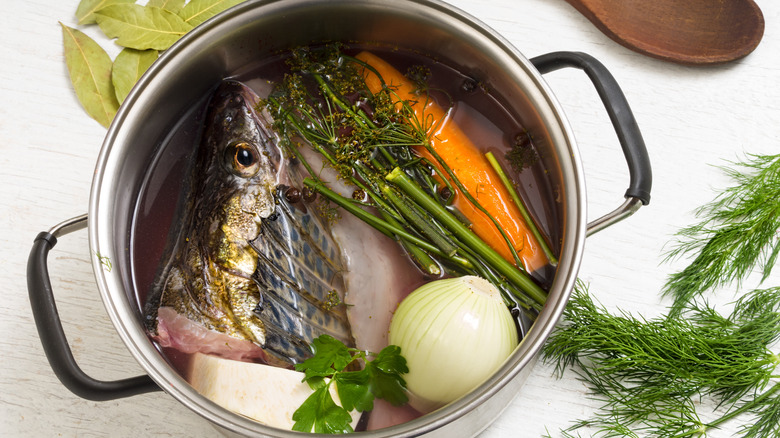Don't Throw Out Those Fish Scraps. Make Stock Instead
A ton of research has been done into the health benefits of fish, and it's a long list that only starts with the fact that they're packed full of important vitamins and nutrients. Fish has also been linked to lowering the risk of things like heart attacks, strokes, the development of autoimmune diseases, and even asthma, according to Healthline. A great way to get all of those benefits is to buy whole fish, then, when fileted, use the scraps for a stock that can be included in a myriad of recipes and dishes.
There are numerous benefits to be had here because, believe it or not, you should actually be eating more fish heads. Fish heads, fish bones, and even the tails can be boiled down into a homemade fish stock that will take your next fish chowder to the next level. That stock will contain a delicious umami flavor that can add a whole new dimension to everything from stews and sauces to salad dressings.
The good news is that it's easier than you might think. Fish stock can easily be made in the time it takes you to cook dinner, and once you start experimenting with this rich, flavorful ingredient, you might wonder how you ever got away with not having some in the fridge.
Fish stock is easy to make
The best way to get both fresh fish for dinner and substantial scraps for stock is to buy whole fish from a trusted fishmonger or grocery store. Look for a fish with clear eyes, firm scales, intact and untorn fins, and a bright red color inside the gills. Check all those boxes, and you'll get delicious filets and a delicious stock, too.
Fish stock can be made from the scraps of whatever you're fileting for dinner, but there are some things to remember. Different types of fish will produce different types of stock, and if you're using cod or haddock, you'll have a mild stock. On the other hand, fish with stronger flavors — like salmon or tuna — will produce a more fishy-tasting stock. That might change what you decide to do with it, as flavors perfect for chowder might not be what you want in a salad dressing.
It'll only take around 20 minutes to cook the scraps down enough that they start to turn into gelatin and give you that thick, smooth texture that adds not just flavor but body to anything it's used in. Make it while you're making dinner and your fish is still fresh, and here's a pro tip: Make sure you clean the fish scraps well. Wash away any blood, remove the gills, and get rid of any veins. If those things are left in, they'll turn your stock from a delicious ingredient to a funky failed experiment.
There are many benefits to buying whole fish and making stock
The obvious benefit of making fish stock is that it's a brilliant way to add flavor to many dishes. Use it when cooking rice or grains, swap out some of the liquid components of your favorite marinade in favor of fish stock, or use it the next time you go to poach, braise, or steam fish. Serving up seafood pasta? Use it to finish cooking the pasta for an extra umami burst of flavor. And, of course, it's a crucial ingredient in a delicious seafood soup.
But there are other benefits to buying whole fish and taking a nose-to-tail approach, starting with the fact that it cuts down on food waste. When fish are processed and sold in pieces, there's generally a lot that gets thrown away. That's a shame, as those pieces still contain valuable vitamins and nutrients. You'll also be getting more bang for your buck as not only is whole fish generally cheaper, but you'll be able to stretch that fish farther.
It's also a great way to guarantee you're getting the freshest fish possible. When you plan ahead for making fish stock, you'll be buying the whole fish, and you'll get to see exactly how fresh it is. You don't know the provenance of filets, but when you see the whole thing, you know precisely what you're putting on your plate.


